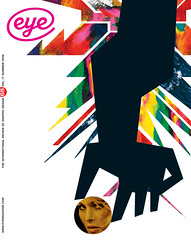Summer 2008
Credits where due
Uncredited: Graphic Design and Opening Titles in Movies
By Gemma Solana and Antonio Boneu<br>Index Books, £45, €55 including DVD<br>How do you make God laugh? Make plans! How do you make your publisher cry? Make plans to do a book on movie title sequences!
Over ten years ago I attempted to do just that. Three-quarters through the research I hit a brick wall – the movie studios. While the featured designers were cooperative, none owned the rights to their work. The studios or producers did. Obtaining permissions is tedious, yet the first few studios I contacted graciously granted rights for publication. I was confident about approaching the rest. Note to self: never get overly confident!
Some did not respond, others forwarded the request to their lawyers (who did not respond), still others agreed, as long as I paid 0 or more per frame (which would have equalled at least k). The book was ultimately dropped. But I was not alone: other would-be authors of similar books were likewise stymied. Which is why I was surprised to see Uncredited: Graphic Design & Opening Titles in Movies for sale in New York.
Yet, upon opening the 300-plus page volume, I was disappointed to see hundreds of sequences reproduced at small size without any scale changes. It looked as though the authors simply took digital screen-grabs at the only size that would allow unadulterated reproduction, which in turn was a difficult size at which to appreciate the quality of design.
But when I started making my way through the book, my admiration for Solana and Boneu’s efforts increased exponentially. Not only did they survey work of acknowledged masters – Saul Bass, Pablo Ferro, Dan Perri, Maurice Binder, Richard Greenberg, Randy Balsmayer, Robert Dawson and more – they found work by less acknowledged but no less innovative pioneers.
The title is something of a misnomer. While there are various ‘uncredited’ sequences, the authors uncovered many designers who had long been left for anonymous. The ubiquitous on-screen credit for Pacific Title & Art Studio is also detailed, having been founded by Leo Schlesinger (creator of Bugs Bunny).
The great virtue and surprise of Uncredited is its refusal to hold true to the canon of title design and designers. One forgotten star was Lotte Reiniger, a German film-maker who designed titles for her 1915 film, Der Golem (see Eye no. 60 vol. 15). Another was Mary Ellen Bute, an experimental cineaste, who directed such typographical ‘ballets’ as Spook Sport (1939) and Tarantella (1940), her early ‘electronic visual’ experiment of type and abstract image. A real eye-opener was the work of Sandy Dvore, whose TV credits included the comic opener for The Partridge Family and an iconic one for Falcon Crest, and who was responsible for the expressionist titles for The Dunwich Horror (1970) and the pre-deconstructive approach to Blacula (1972).
There is also a parlour-game quality to Uncredited insofar as the reader is challenged to guess who did what. I was floored to read that the cartoonist Andre François designed Roman Polanski’s 1967 Dance of the Vampires and Ronald Searle was responsible for the 1966 Those Magnificent Men in Their Flying Machines. While I knew Richard Williams was responsible for some of the Pink Panther titles, I had not seen his 1965 The Liquidator, a typographic spectacular that could have been done yesterday. Nor had I any idea that Bob Gill designed the wonderfully gaudy titles for The 7th Voyage of Sinbad (1958).
It is also revelatory to discover the famous film directors who designed their own titles: Orson Wells for The Magnificent Ambersons (1942), Jean-Luc Goddard for Made in U.S.A. (1966), and Francois Truffaut’s sequence for Fahrenheit 451, where a narrator announces the actors’ names. (See Michael Worthington’s article in this issue.)
There is such a wealth of material here that the small size of the frames is not really a handicap, and actually allows the designers, Mario Eskenazi and Diego Feijoo, to show more details than radical scale changes would allow. With the accompanying DVD, which contains over a dozen of the sequences, this book fills a huge gap in the literature of motion graphics. So I won’t even ask whether they got permission to run all the sequences – I don’t want to know.
First published in Eye no. 68 vol. 17 2008
Eye is the world’s most beautiful and collectable graphic design journal, published quarterly for professional designers, students and anyone interested in critical, informed writing about graphic design and visual culture. It is available from all good design bookshops and online at the Eye shop, where you can buy subscriptions and single issues.

